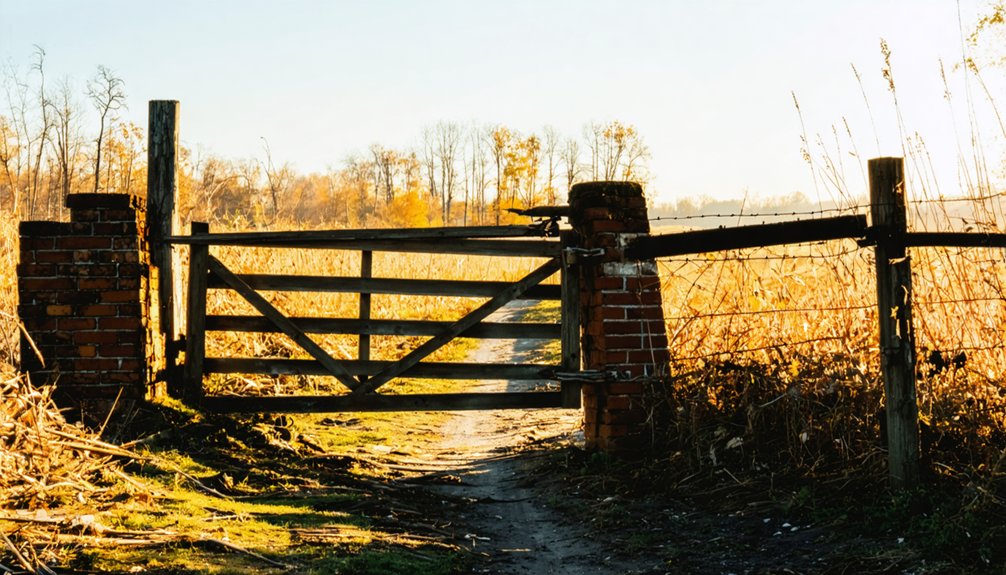You’ll find Elm Point’s remains nine miles northwest of Greenville, Illinois along State Route 127. This ghost town emerged in 1856 when Anthony Hill established it for William P. Libby amid fertile prairie lands. Though it boasted a post office and appeared on the 1875 Warner & Beers Plat Atlas Map, the settlement’s growth stalled when railroads bypassed it. By the late 19th century, this once-promising agricultural community had faded into Bond County’s landscape, where its story still echoes.
Key Takeaways
- Founded in 1856 by Anthony Hill, Elm Point was located nine miles northwest of Greenville, Illinois along State Route 127.
- The settlement included a post office but failed to achieve significant growth or cultural development in its brief existence.
- Economic decline accelerated when major railroads bypassed the town, leading to its isolation and eventual abandonment.
- The town appeared on historical maps until 1876, including the notable 1875 Warner & Beers Plat Atlas Map.
- The ghost town’s legacy is preserved through oral histories, academic research, and local educational initiatives.
The Rise and Fall of a Prairie Settlement
While many prairie settlements in Illinois flourished during the mid-1800s, Elm Point’s story took a different turn.
You’ll find its origins on May 17, 1856, when Anthony Hill planned the town for William P. Libby along what’s now Illinois State Route 127. The settlement emerged amid well-cultivated prairie land, promising agricultural opportunities for those seeking their fortune. The town was positioned nine miles northwest of Greenville, Illinois.
Despite its strategic location and the establishment of a post office, Elm Point’s community dynamics never gained momentum. The town’s cultural significance remained minimal, without any notable traditions or events to bind its residents together. Like New Philadelphia’s decline, Elm Point suffered when the railroad bypassed the settlement.
Even with essential infrastructure in place, Elm Point struggled to develop the communal spirit that transforms a settlement into a thriving town.
Unlike other successful settlements of the era, you won’t find records of major industries or significant external investments. The prairie settlement gradually faded, and today, farmland has reclaimed where hopeful settlers once aimed to build their dreams.
Historical Maps and Geographic Positioning
Historical maps offer precise documentation of Elm Point’s existence through the late 19th century. You’ll find the settlement’s cartographic representation most significantly in the 1875 Plat Atlas Map by Warner & Beers, showcasing its historical significance within Bond County, Illinois. Modern browser verification systems help researchers securely access these historical maps online.
Located approximately nine miles northwest of Greenville at 39°0’21” N and 89°28’25” W, Elm Point straddled the boundary between Lagrange and Shoal Creek Townships. You can trace its position along today’s Illinois State Route 127, where Elm Point Avenue now marks the former village site. The Williamson County Historical Society continues to map and document ghost towns like Elm Point to preserve their historical legacy.
The town’s strategic placement at 607 feet above sea level made it a remarkable prairie settlement. Historical maps reveal its network of roads and infrastructure, including a post office that served as a crucial connection point for local residents.
Life in 19th Century Elm Point
Like many rural Illinois settlements of its time, life in Elm Point centered around agricultural pursuits after its founding by Anthony Hill in 1856.
You’d have found yourself among well-cultivated prairie lands, where community dynamics revolved around local trade and farming activities. Early settlers kept close to nearby forts for protection during periods of unrest. The post office served as a crucial connection to the outside world, though the settlement never grew substantially.
Wildlife interactions were part of daily life, with deer and wolves roaming the surrounding areas.
If you’d lived in Elm Point, you would’ve relied on nearby Greenville, just nine miles away, for larger market connections.
While specific details about schools and cultural events aren’t well-documented, you would’ve experienced a typical rural lifestyle where family gatherings and local traditions shaped the community’s social fabric.
Agricultural Heritage and Land Use
You’ll find that Elm Point’s transformation from prairie to farmland reflects Bond County’s broader agricultural patterns, with settlers strategically establishing homesteads that incorporated both timber and prairie sections.
Similar to how George Davidson entered 160 acres to establish Greenville, early settlers in Elm Point acquired land parcels to develop farming operations.
The area’s well-cultivated countryside supported diverse farming operations, where grains like wheat, corn, and oats thrived in the local soil conditions. The early farmers encountered tall prairie grass that could conceal a mounted horseman, presenting a significant challenge when breaking new ground.
Around Elm Point’s farms, you’d have seen the gradual shift from manual farming methods to mechanized equipment, as innovations like seed drills and reapers made their way into daily agricultural operations.
Prairie Farming Patterns
As settlers first encountered the vast prairies of Elm Point, they mistakenly dismissed the treeless landscape as infertile, unaware they’d stumbled upon some of the world’s richest agricultural land.
You’ll find that Native Americans had already mastered sustainable practices here, cultivating “The Three Sisters” – corn, beans, and squash – through sophisticated crop rotation techniques since 900 AD.
Breaking the dense prairie sod proved challenging until technological innovations like the self-scouring steel plow arrived in 1837. Prairie Farmer magazine consistently published soil conservation methods to help farmers maintain the land’s fertility.
You can trace how these advances transformed Elm Point’s landscape, as farmers rapidly converted the nutrient-rich grasslands to cropland. Wheat was initially a vital pioneer crop for both local consumption and market sales.
The prairie’s natural fertility, enhanced by centuries of grass root systems and organic matter decomposition, yielded impressive harvests – sometimes reaching 120 bushels of corn per acre in nearby American Bottom.
Settlement to Farmland Transition
While early farmers conquered the prairie’s challenges, new settlements began dotting the Illinois landscape, including Elm Point – established on May 17, 1856, by Anthony Hill for William P. Libby.
You’ll find this settlement’s story reflects the dynamic shifts many Illinois communities faced, where economic challenges ultimately transformed populated areas back into farmland.
Located along Illinois State Route 127 between Lagrange and Shoal Creek Townships, Elm Point struggled to maintain its foothold.
By 1876, the settlement’s presence on maps began to fade as agricultural practices took precedence over town development. Like many communities such as Delevan and Commerce, the town’s dreams of railroad connections and economic growth never materialized.
The well-cultivated fields surrounding Elm Point ultimately reclaimed the townsite, leaving only Elm Point Avenue as a reminder of its existence.
Today, the land supports the region’s farming tradition through row crop production.
The Role of Early Transportation Routes

If you’d explored Elm Point in its early days, you would’ve found it strategically positioned at the crossroads of important trade routes, including what later became State Route 127.
The village’s location along established overland paths initially promised growth potential, especially for stagecoach traffic and local commerce.
However, Elm Point’s fate was sealed when railroads bypassed the settlement, causing trade and travelers to favor rail-connected towns while road-dependent communities withered.
Railway Vs Road Access
Two critical transportation networks shaped the destiny of Elm Point: railways and roads.
You’ll find that railway advantages played a decisive role in the town’s fate, as the major rail lines bypassed the settlement, cutting off essential economic opportunities. While roads eventually connected Elm Point to neighboring areas, these road limitations couldn’t compensate for the absence of rail access.
Consider these key factors that impacted Elm Point’s transportation situation:
- Railway bypass severely restricted the town’s ability to participate in regional trade and commerce.
- Limited road maintenance resources made it difficult to maintain reliable connections with other settlements.
- The combined lack of both efficient rail and road infrastructure ultimately contributed to the town’s economic isolation.
The absence of thorough transportation access proved insurmountable for Elm Point’s survival.
Early Trade Routes Impact
Before Elm Point’s establishment, Native American trade networks and trails profoundly shaped the region’s transportation landscape. Indigenous commerce flowed along natural waterways like the Des Plaines River, while established footpaths connected tribal settlements across northern Illinois.
You’ll find that these early trade networks laid the groundwork for European settlement patterns. When pioneers arrived in the 1820s-1840s, they followed these pre-existing routes, which evolved into essential roads radiating from Chicago.
These paths weren’t random – they followed strategic portage points and natural topography that Native Americans had used for centuries. The Milwaukee Road, emerging from an ancient trail, became critical for settlements like Elm Point, linking isolated prairie communities to growing markets.
This indigenous-influenced transportation web would later guide canal and railway development.
Stagecoach Stop Opportunities
While stagecoaches traversed Illinois’s expanding frontier in the 1830s-1850s, strategic rest stops became essential hubs for both travelers and developing communities.
Elm Point’s location along what’s now Route 127 positioned it within the stagecoach dynamics of Bond County, potentially serving as a waypoint in the region’s rural connectivity network.
Consider these key aspects of stagecoach operations that might’ve influenced Elm Point:
- Stops were typically spaced to accommodate horse changes and passenger rest every 10-15 miles.
- Post offices often doubled as stagecoach stops, and Elm Point maintained one during its existence.
- Local businesses like taverns and stables frequently emerged around established stop points.
Though no direct records confirm Elm Point as an official stagecoach stop, its position and post office suggest it likely played some role in the area’s transportation network.
From Settlement to Abandoned Site

As settlers pushed westward across Illinois in the mid-1800s, Anthony Hill laid out Elm Point as a townsite for William P. Libby on May 17, 1856.
Located nine miles northwest of Greenville, this prairie settlement established basic civic features including a post office, showing early signs of community organization.
Nine miles from Greenville sat a frontier outpost where early settlers built their first shared civic amenities.
You’ll find Elm Point’s location marked today only by Elm Point Avenue, near the intersection of Lagrange and Shoal Creek Townships.
While it appeared on maps until 1876, the settlement never achieved significant growth or development.
Unlike other ghost towns that vanished due to disasters, Elm Point’s decline stemmed from lack of economic opportunities and rail connections.
The site has since returned to farmland, leaving behind no visible structures – just another indication of the fleeting nature of frontier settlements.
Bond County’s Lost Community
Since its establishment in 1817, Bond County has witnessed the rise and fall of numerous settlements, with Elm Point standing out as one of its most notable lost communities.
The area’s historical significance stems from its strategic location nine miles northwest of Greenville, where Anthony Hill laid out the town in 1856 for William P. Libby.
The community’s resilience was evident through:
- A thriving agricultural economy supported by substantial farmers and well-cultivated land
- Essential infrastructure including a post office that served the surrounding population
- Strong connections to other Bond County settlements via improved roads and bridges
Today, you’ll find only Elm Point Avenue and the cemetery marking where this vibrant community once stood, though its legacy lives on through the preservation efforts of the Bond County Historical Society.
Architectural and Infrastructure Legacy

Though Elm Point was formally established in 1856 with a structured town plan, its architectural legacy remains remarkably sparse.
You’ll find no surviving buildings from the original settlement, and records don’t indicate any notable architectural styles or substantial structures ever existed there. The town’s infrastructure challenges were significant – while it had access to State Route 127, it lacked railroad connections that might’ve spurred growth and development.
Today, you can trace Elm Point’s existence through just a few remaining markers: the rural cemetery that still stands, and Elm Point Avenue, which bears the ghost town’s name.
This minimal footprint reflects a common fate of many small prairie settlements that couldn’t overcome their limited infrastructure and eventually faded into history.
Environmental Impact and Adaptation
You’ll notice how Elm Point’s landscape transformation reflects broader patterns of prairie land conversion throughout Illinois, where native grasslands gave way to agricultural development.
The town’s historical natural resource management practices, particularly during its brief period of settlement, left lasting impacts on local soil composition and watershed dynamics.
While the ghost town’s abandoned status has allowed for some natural regeneration, you can still observe the lingering effects of early settlement practices in the area’s current ecological makeup.
Prairie Land Conversion Patterns
While Elm Point’s fate mirrors many lost prairie settlements of Illinois, its story particularly highlights the dramatic transformation of native grasslands during the 19th century.
You’ll find that urban abandonment was common among settlements that couldn’t secure critical infrastructure or maintain economic viability. The town’s 1856 layout and subsequent disappearance by 1876 reflects the broader pattern of failed prairie settlements reverting to farmland.
Here’s what made Elm Point’s conversion typical of the era:
- Initial settlement required extensive prairie ecosystem modification through leveling and plowing.
- The town’s failure led to agricultural reclamation rather than sustained urban development.
- The land’s transformation represents the dominant pattern of agriculture overtaking attempted urbanization.
These changes permanently altered soil composition, drainage patterns, and native habitat structures throughout the region.
Natural Resource Management Legacy
Despite Elm Point’s abandonment in the late 19th century, its industrial legacy continues to plague surrounding areas with persistent soil and water contamination.
You’ll find this natural resource management legacy reflected in the degraded habitats and compromised ecosystems throughout the region, where native wildlife populations struggle to survive.
The area’s toxic heritage has created lasting environmental challenges you can’t ignore.
Coal plants and abandoned industrial sites have left behind dangerous pollutants that threaten local biodiversity and human health.
While community organizations are pushing for restoration projects and cleanup initiatives, the path to recovery isn’t simple.
You’ll see ongoing efforts to reclaim natural areas like dunes and lakeshores, but the complex contamination profiles make complete remediation a formidable task that requires sustained, collaborative action.
Preserving the Memory of Elm Point
Although Elm Point no longer exists as a physical settlement, dedicated efforts preserve its memory through various means.
You’ll find its legacy living on through oral histories collected from local residents and cultural markers like Elm Point Avenue, which traces the original town’s location at 39°00′21″N latitude and 89°28′25″W longitude.
The preservation of Elm Point’s history continues through:
- Academic research and presentations by scholars like Dr. Neil Gale, who’ve documented the town’s role in Bond County.
- Digital mapping initiatives and photographic archives that maintain records of the former prairie settlement.
- Community engagement through social media, historical blogs, and local events that share stories of this lost Illinois town.
Local schools and libraries serve as custodians of Elm Point’s heritage, safeguarding documents and artifacts for future generations.
Frequently Asked Questions
What Native Tribes Originally Inhabited the Elm Point Area?
You’ll find that the Illinois Confederation’s Native tribes, including the Peoria, Kaskaskia, Cahokia, Michigamea, Moingwena, and Tamaroa, originally claimed historical significance in the Elm Point territory.
Were There Any Notable Crimes or Incidents Reported in Elm Point?
Quick as a whisper, you’ll find there aren’t any documented unsolved mysteries or notable crimes in historical records. You won’t uncover any significant incidents from this small Illinois settlement.
What Was the Highest Recorded Population of Elm Point?
You won’t find exact population records in Elm Point’s history, though based on its classification as a hamlet and demographic patterns, the settlement likely never exceeded 200 residents at its peak.
Did Any Famous Historical Figures Ever Visit Elm Point?
You won’t find records of any famous visitors to this small Bond County settlement. Historical significance remained purely local, with no documented visits from notable national or international figures.
What Happened to the Cemetery or Burial Grounds of Elm Point?
You’ll find Elm Point Cemetery still exists today with over 200 memorial records spanning from the late 1700s through the 20th century, preserving local burial customs and serving as a historical landmark.
References
- https://www.youtube.com/watch?v=93k0qtvzkn4
- https://drloihjournal.blogspot.com/2017/04/lost-towns-of-illinois-elm-point.html
- http://cantontornado36.blogspot.com/2017/04/ghost-towns-of-fulton-county-illinois.html
- https://drloihjournal.blogspot.com/p/lost-towns-of-illinois-series.html
- https://en.wikipedia.org/wiki/Elm_Point
- https://bond.illinoisgenweb.org/pdfs/1905greenvillesouvenir.pdf
- https://en.wikipedia.org/wiki/List_of_ghost_towns_in_Illinois
- https://history.weld.gov/County-150/Weld-County-Towns/Ghost-Towns-in-Weld-County
- http://livinghistoryofillinois.com/pdf_files/Elm Point
- https://www.wcihs.org/history/williamson-county-illinois-town-ghost-town-village-and-station-map/



